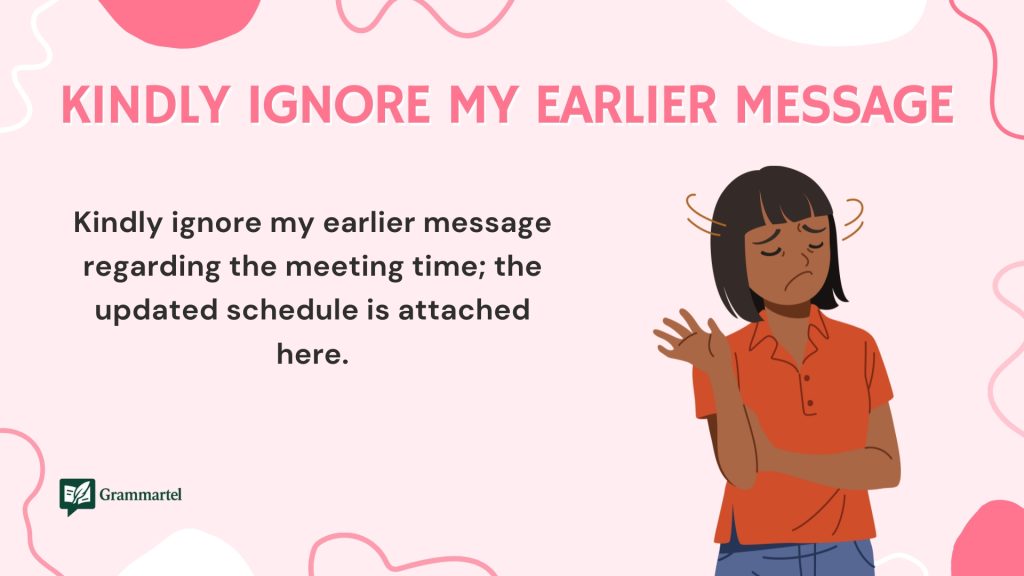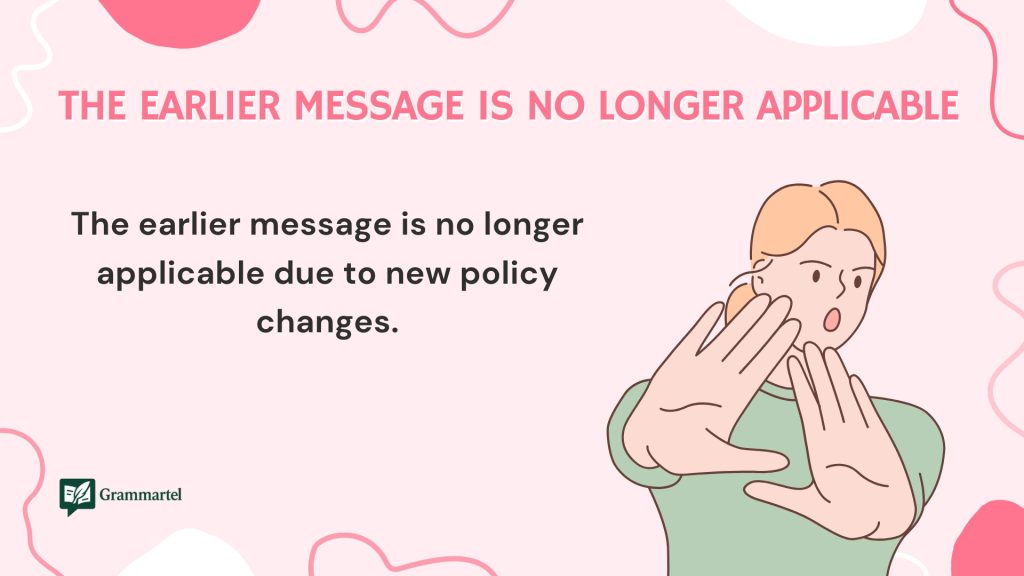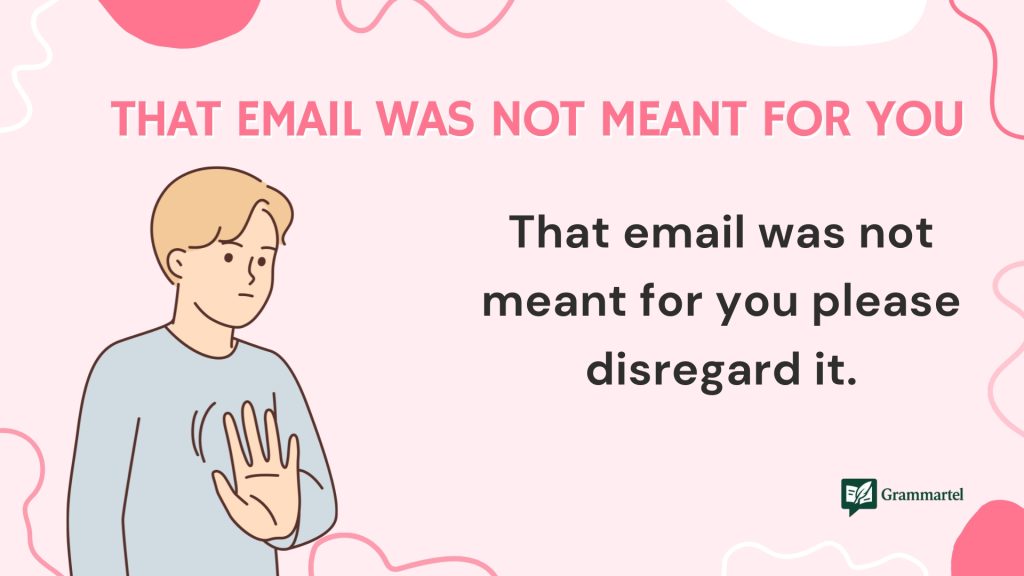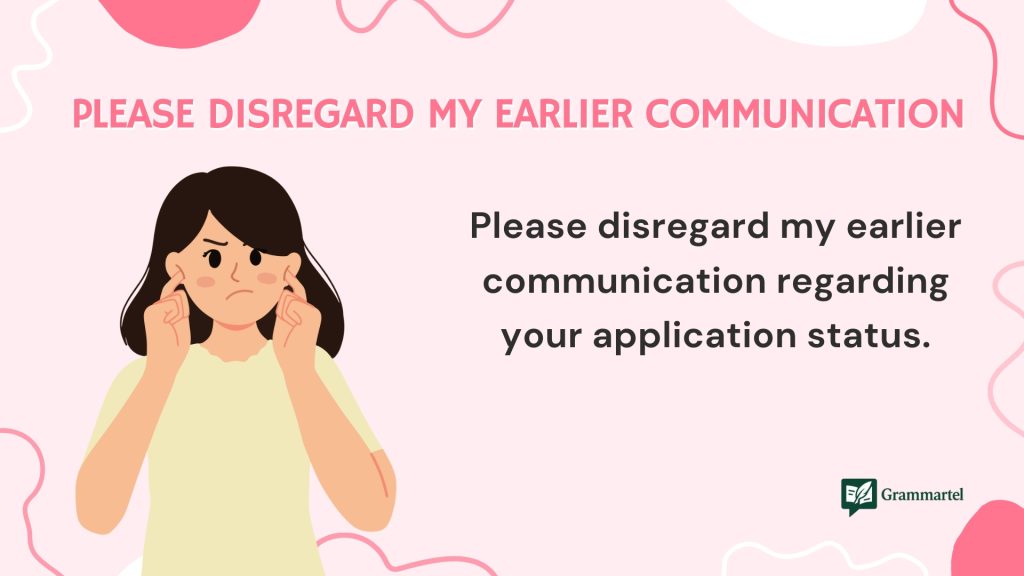We’ve all been there—you hit “send” too soon, and suddenly your email has a typo, missing file, or just the wrong info. Oops. Now what? Well, the good news is, there are plenty of polite, professional ways to say, “Please disregard my previous email.” Whether you’re dealing with a client, manager, or teammate, it’s all about sounding clear and respectful—without sounding too awkward or apologetic. In this guide, you’ll find 40 useful phrases to help you handle those little email slip-ups like a pro, with real examples you can borrow or tweak as needed.
What Does “Please Disregard My Previous Email” Mean?
The phrase “Please disregard my previous email” is a polite way to ask someone to ignore your last message. You might use it if you sent an email by mistake, forgot something important, or gave the wrong information. It helps clear up confusion and shows that you’re aware of the error.
When to Use “Please Disregard My Previous Email”
Use this phrase when you need to correct a mistake quickly. For example, if you sent an email with the wrong meeting time, or attached the wrong file, it’s best to follow up right away. It’s also helpful if you realize you sent an email to the wrong person. Always keep your tone calm and respectful. Mistakes happen—how you respond matters.
40 professional Ways to Say “Please Disregard My Previous Email”
1. Kindly ignore my earlier message

Meaning: Asking the recipient to disregard a previous email.
Explanation: Polite and formal, often used in professional correspondence.
Example: Kindly ignore my earlier message regarding the meeting time; the updated schedule is attached here.
Best Use: Business or corporate settings with formal communication.
Worst Use: Casual chats or friendly emails—it may sound too stiff.
Tone: Formal, courteous.
2. Please ignore the message I sent earlier
Meaning: Direct request to disregard an earlier email.
Explanation: Slightly less formal but still polite; clear and easy to understand.
Example: Please ignore the message I sent earlier—there was a typo in the invoice.
Best Use: When clarity is more important than formality.
Worst Use: High-stakes situations requiring very careful wording.
Tone: Neutral, straightforward.
3. Apologies, the previous email was sent in error
Meaning: Admitting that the prior email was a mistake.
Explanation: Combines an apology with a polite disregard request.
Example: Apologies, the previous email was sent in error. Please refer to the attached updated report.
Best Use: When you need to acknowledge a mistake upfront.
Worst Use: If the mistake is sensitive or potentially damaging.
Tone: Polite, accountable.
4. Disregard my last email, please
Meaning: Simple request to ignore the last sent message.
Explanation: Conversational and concise; works well with colleagues you know well.
Example: Disregard my last email, please—I’ve now received the updated figures.
Best Use: Internal communication within a small team.
Worst Use: Formal customer or client correspondence.
Tone: Casual, friendly.
Explore more : 40 Best Ways to Say “Sweet Dreams” (With Examples).
5. Please refer to this email instead
Meaning: Directing attention to the current email instead of the previous one.
Explanation: Focuses on the correction rather than the error.
Example: Please refer to this email instead for the correct meeting agenda.
Best Use: When the updated message is more important than highlighting the mistake.
Worst Use: If you need to explicitly admit an error for accountability.
Tone: Polite, optimistic.
6. Ignore the earlier email—updated details below
Meaning: Request to disregard old info and look at the corrected version.
Explanation: Keeps the message action-oriented.
Example: Ignore the earlier email—updated details are below with the correct time.
Best Use: Project updates or scheduling corrections.
Worst Use: When the original email caused confusion or offense (needs more formality).
Tone: Direct, solution-focused.
7. Please disregard my last note
Meaning: Politely ask the recipient to ignore the previous message.
Explanation: Using “note” softens the formality.
Example: Please disregard my last note about the shipment; the tracking number has changed.
Best Use: Semi-formal communication.
Worst Use: Legal or contractual communications.
Tone: Neutral, polite.
8. Sorry, my last message was incorrect
Meaning: Apology plus admission of error.
Explanation: Humanizes the correction—good for rapport.
Example: Sorry, my last message was incorrect. The meeting is at 3 PM, not 2 PM.
Best Use: Small mistakes that need quick correction.
Worst Use: Highly sensitive errors in formal contexts.
Tone: Friendly, apologetic.
9. Disregard my previous correspondence
Meaning: Request to ignore prior communication.
Explanation: Very formal—ideal for official letters or serious topics.
Example: Please disregard my previous correspondence regarding the policy change; updated terms are attached.
Best Use: Government or legal communications.
Worst Use: Casual office banter.
Tone: Formal, authoritative.
10. That last email can be ignored
Meaning: Informal notice that the prior email isn’t relevant anymore.
Explanation: Relaxed phrasing, easy for casual team communication.
Example: That last email can be ignored—I found the missing file.
Best Use: Among colleagues or friends.
Worst Use: With new clients or high-level management.
Tone: Casual, lighthearted.
11. Please ignore my earlier correspondence
Meaning: A formal way to ask someone to disregard a previous email or letter.
Explanation: Best for professional or legal contexts.
Example: Please ignore my earlier correspondence regarding the contract; the updated version is attached.
Best Use: Formal corporate or legal communications.
Worst Use: Friendly or casual settings.
Tone: Formal, respectful.
12. The last email was incorrect—see updated info below
Meaning: Acknowledging an error and providing the corrected version in the same message.
Explanation: Efficient and direct, shifting focus to the update.
Example: The last email was incorrect—see updated info below for accurate shipment dates.
Best Use: When speed and clarity matter.
Worst Use: Highly sensitive issues requiring a softer approach.
Tone: Direct, corrective.
13. My apologies, the prior message was outdated
Meaning: Admitting the previous message had old or irrelevant information.
Explanation: Keeps the tone professional but courteous.
Example: My apologies, the prior message was outdated; please refer to the latest attached file.
Best Use: Updating reports, data, or schedules.
Worst Use: Casual conversations—it sounds too formal.
Tone: Polite, professional.
14. The earlier message is no longer applicable

Meaning: Informing that the previous email’s content is not valid anymore.
Explanation: Neutral phrasing without implying a personal mistake.
Example: The earlier message is no longer applicable due to new policy changes.
Best Use: When updates are due to external changes.
Worst Use: Where personal accountability is expected.
Tone: Neutral, informative.
15. Please ignore my previous update
Meaning: Requesting to disregard a prior update because it has changed.
Explanation: Keeps things simple without overexplaining.
Example: Please ignore my previous update on the training schedule; see the revised one attached.
Best Use: Frequent update scenarios like project management.
Worst Use: When the error had serious consequences.
Tone: Neutral, concise.
16. The last information I sent was incorrect
Meaning: Admitting that your last communication contained wrong details.
Explanation: Clear, straightforward ownership of the error.
Example: The last information I sent was incorrect—please use the attached document instead.
Best Use: When honesty and directness are valued.
Worst Use: Very formal or sensitive client communications.
Tone: Direct, candid.
17. Sorry, disregard what I sent earlier
Meaning: A casual way to ask someone to ignore your last message.
Explanation: Works best when you have a friendly relationship with the recipient.
Example: Sorry, disregard what I sent earlier—I found the correct spreadsheet now.
Best Use: Internal team chats or friendly client relationships.
Worst Use: Government or high-formality communications.
Tone: Casual, apologetic.
18. Please read this instead of my earlier message
Meaning: Directs the recipient’s focus to the new message.
Explanation: Encourages moving forward rather than dwelling on the mistake.
Example: Please read this instead of my earlier message regarding the budget proposal.
Best Use: When the new information is more important than the error.
Worst Use: If transparency about mistakes is critical.
Tone: Polite, optimistic.
19. That earlier message was an error
Meaning: States plainly that the last message was sent in error.
Explanation: Cuts to the point without added fluff.
Example: That earlier message was an error—please delete it and see the corrected version attached.
Best Use: Time-sensitive corrections.
Worst Use: Formal communications where softer language is expected.
Tone: Blunt, direct.
20. My previous email contained incorrect details
Meaning: Admitting that the prior email had wrong information.
Explanation: Keeps the tone formal and clear.
Example: My previous email contained incorrect details about the launch date. Please see the corrected timeline attached.
Best Use: Professional settings with factual corrections.
Worst Use: Informal chats.
Tone: Formal, precise.
21. Please disregard my earlier reply
Meaning: Asking the recipient to ignore your earlier response in a thread.
Explanation: Useful for email chains where quick corrections are needed.
Example: Please disregard my earlier reply—here is the accurate answer to your query.
Best Use: Ongoing conversations with multiple messages.
Worst Use: One-off formal letters.
Tone: Neutral, direct.
22. The last email was sent by mistake
Meaning: Informing that the last message should not have been sent.
Explanation: Suggests an unintentional action rather than wrong info.
Example: The last email was sent by mistake—please ignore it.
Best Use: When you hit “send” too soon or to the wrong person.
Worst Use: Where the content may cause concern—needs more reassurance.
Tone: Honest, casual.
23. That message shouldn’t have gone out
Meaning: A casual admission that the previous email was not intended.
Explanation: Friendly tone; works best internally.
Example: That message shouldn’t have gone out—please ignore it.
Best Use: Small teams or informal settings.
Worst Use: External communications with stakeholders.
Tone: Casual, lighthearted.
24. Please ignore the note I sent earlier today
Meaning: Request to disregard an email from earlier the same day.
Explanation: Adds time reference for clarity.
Example: Please ignore the note I sent earlier today about the budget; it’s been revised.
Best Use: Day-to-day work corrections.
Worst Use: When timing isn’t relevant.
Tone: Polite, neutral.
25. Disregard the earlier update, see this one
Meaning: Directly replacing a prior message with the new one.
Explanation: Keeps the conversation moving forward.
Example: Disregard the earlier update, see this one for the accurate project milestones.
Best Use: Ongoing project communications.
Worst Use: Sensitive topics that need more careful handling.
Tone: Action-oriented, direct.
26. That email was not meant for you

Meaning: Clarifying that the message was sent to the wrong person.
Explanation: Clears up confusion quickly.
Example: That email was not meant for you—please disregard it.
Best Use: Accidental sends to unintended recipients.
Worst Use: Internal updates where everyone’s on the same topic.
Tone: Clear, apologetic.
27. Please ignore the previous thread
Meaning: Asking to disregard a whole conversation chain.
Explanation: Useful when the entire discussion is no longer relevant.
Example: Please ignore the previous thread; the issue has been resolved.
Best Use: Large group emails where the topic has changed.
Worst Use: One-on-one communication.
Tone: Neutral, direct.
28. The earlier message is invalid
Meaning: Declares the prior message as incorrect or no longer applicable.
Explanation: Firm and to the point.
Example: The earlier message is invalid—please refer to the attached updated plan.
Best Use: Formal updates with authoritative tone.
Worst Use: Casual work environments.
Tone: Formal, decisive.
29. Please disregard what I said earlier
Meaning: Requesting someone to ignore prior communication, spoken or written.
Explanation: Slightly more personal phrasing.
Example: Please disregard what I said earlier about the schedule—it has changed.
Best Use: Small team or informal communication.
Worst Use: Large formal audience.
Tone: Conversational, polite.
30. That information is no longer correct
Meaning: Letting the recipient know that the old information is outdated.
Explanation: Softens the focus on personal fault.
Example: That information is no longer correct—please use the figures in this email.
Best Use: Updates caused by external changes.
Worst Use: When you need to take clear ownership of the mistake.
Tone: Neutral, factual.
31. The earlier update has been replaced
Meaning: Informing the recipient that the last update is superseded by the new one.
Explanation: Neutral, process-focused phrasing.
Example: The earlier update has been replaced by the attached report.
Best Use: Project management or status updates.
Worst Use: Casual personal messages.
Tone: Professional, neutral.
32. Please disregard my earlier instruction
Meaning: Request to ignore a prior directive or request.
Explanation: Works well in hierarchical or team settings.
Example: Please disregard my earlier instruction about the data entry process.
Best Use: Correcting work orders or directives.
Worst Use: Friendly chats.
Tone: Professional, clear.
33. That earlier message contained errors
Meaning: Acknowledging mistakes in the previous email.
Explanation: Balances accountability with a factual tone.
Example: That earlier message contained errors—please review this corrected version.
Best Use: Technical or factual corrections.
Worst Use: Sensitive situations where language needs softening.
Tone: Factual, honest.
34. Please ignore the announcement sent earlier
Meaning: Requesting to disregard a previous public or team-wide announcement.
Explanation: Best for group communications.
Example: Please ignore the announcement sent earlier about the system downtime.
Best Use: Company-wide notices.
Worst Use: One-to-one correspondence.
Tone: Professional, straightforward.
Worth reading : 40 Best Ways to Say “My Availability Is as Follows” (With Examples).
35. The earlier note is not accurate
Meaning: Informing that a previous message contains inaccurate information.
Explanation: Softens the tone by not using “wrong” or “mistake.”
Example: The earlier note is not accurate; please see the revised document.
Best Use: Sensitive corrections.
Worst Use: Situations requiring firm accountability.
Tone: Gentle, professional.
36. Disregard my previous update on this topic
Meaning: Asking someone to ignore an earlier update specifically related to the same matter.
Explanation: Clarifies which message should be ignored.
Example: Disregard my previous update on this topic—here’s the corrected data.
Best Use: Ongoing project or research updates.
Worst Use: General audience communications.
Tone: Specific, polite.
37. That email was sent prematurely
Meaning: Letting someone know the last message was sent before it was ready.
Explanation: Implies timing error rather than content error.
Example: That email was sent prematurely—please wait for the official update.
Best Use: Drafts sent accidentally.
Worst Use: Formal apologies for serious errors.
Tone: Honest, neutral.
38. The message from earlier is no longer valid
Meaning: Indicating that the earlier message no longer applies.
Explanation: Neutral phrasing without personal blame.
Example: The message from earlier is no longer valid; please see updated guidance.
Best Use: Policy changes or procedural updates.
Worst Use: Personal errors needing an apology.
Tone: Formal, informative.
39. Please disregard my earlier communication

Meaning: Asking to ignore a previous email or letter.
Explanation: Very formal and widely acceptable in professional correspondence.
Example: Please disregard my earlier communication regarding your application status.
Best Use: Business and official letters.
Worst Use: Casual chats or internal team banter.
Tone: Formal, respectful.
40. That earlier email is superseded by this one
Meaning: Telling the recipient the new email replaces the old one.
Explanation: Implies structured update rather than a mistake.
Example: That earlier email is superseded by this one—please see the final version attached.
Best Use: Document or version control contexts.
Worst Use: Casual updates.
Tone: Formal, procedural.
Conclusion
Mistakes happen—what really counts is how you handle them. Using the right tone and phrasing can keep things professional and smooth things over quickly. Whether it’s a tiny error or a big mix-up, the key is to acknowledge it without making it a bigger deal than it is. With these 40 polished ways to say “please disregard my previous email,” you’ll always have the right words on hand.
From roadmap to reality Grammartel builds clarity into every move.

